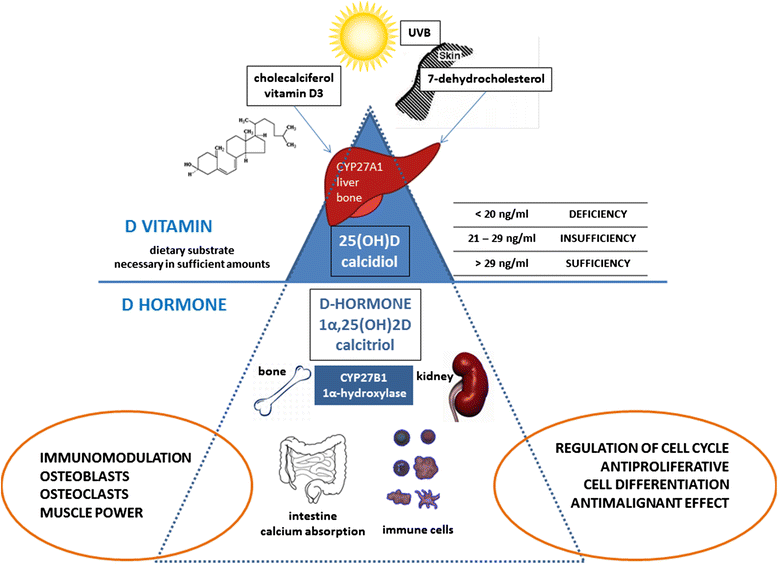Vitamin D—update for the pediatric rheumatologists
- PMID: 26022196
- PMCID: PMC4446840
- DOI: 10.1186/s12969-015-0017-9
Vitamin D—update for the pediatric rheumatologists
Abstract
Vitamin D, upon its discovery one century ago, was classified as a vitamin. This classification still greatly affects our perception about its biological role. 1,25(OH)2D (now known as the D hormone) is a pleiotropic steroid hormone that has multiple biologic effects. It is integral to the regulation of calcium homeostasis and bone turnover as well as having anti-proliferative, pro-differentiation, anti-bacterial, immunomodulatory and anti-inflammatory properties within the body in various cells and tissues. Vitamin D (cholecalciferol) should be considered a nutritional substrate that must be ingested or synthesized in sufficient amounts for the further synthesis of the very important regulatory steroid hormone (D hormone), especially in patients with pediatric rheumatic diseases (PRD). Vitamin D insufficiency or deficiency was shown to be pandemic and associated with numerous chronic inflammatory and malignant diseases and even with increased risk of mortality. Several studies have demonstrated that a high percentage of children with pediatric rheumatic diseases (PRD-e.g., JIA, jSLE) have a vitamin D deficiency or insufficiency which might correlate with disease outcome and flares. Glucocorticoids used to treat disease may have a regulatory effect on vitamin D metabolism which can additionally aggravate bone turnover in PRD. An effort to define the optimal serum 25(OH)D concentrations for healthy children and adults was launched in 2010 but as of now there are no guidelines about supplementation in PRD. In this review we have tried to summarize the strong evidence now suggesting that as the knowledge of the optimal approach to diagnosis and treatment PRD has evolved, there is also an emerging need for vitamin D supplementation as an adjunct to regular disease treatment. So in accordance with new vitamin D recommendations, we recommend that a child with rheumatic disease, especially if treated with steroids, needs at least 2-3 time higher doses of vitamin D than the dose recommended for age (approximately 2000 UI/day). Vitamin D supplementation has become an appealing and important adjunct treatment option in PRD.
References
-
- All Nobel Prizes in Physiology or Medicine - Nobelprize.org [http://www.nobelprize.org/nobel_prizes/medicine/laureates/].
-
- Casimir Funk. The etiology of the deficiency diseases. Beri-beri, polyneuritis in birds, epidemic dropsy, scurvy, experimental scurvy in animals, infantile scurvy, ship beri-beri, pellagra. J State Med. 1912; 20:341–68. - PubMed
-
- Cutolo M, Pizzorni C, Sulli A. Vitamin D endocrine system involvement in autoimmune rheumatic diseases. Autoimmun Rev. 2011;11:84–7. - PubMed
Publication types
MeSH terms
Substances
LinkOut - more resources
Full Text Sources
Other Literature Sources
Medical
Miscellaneous


